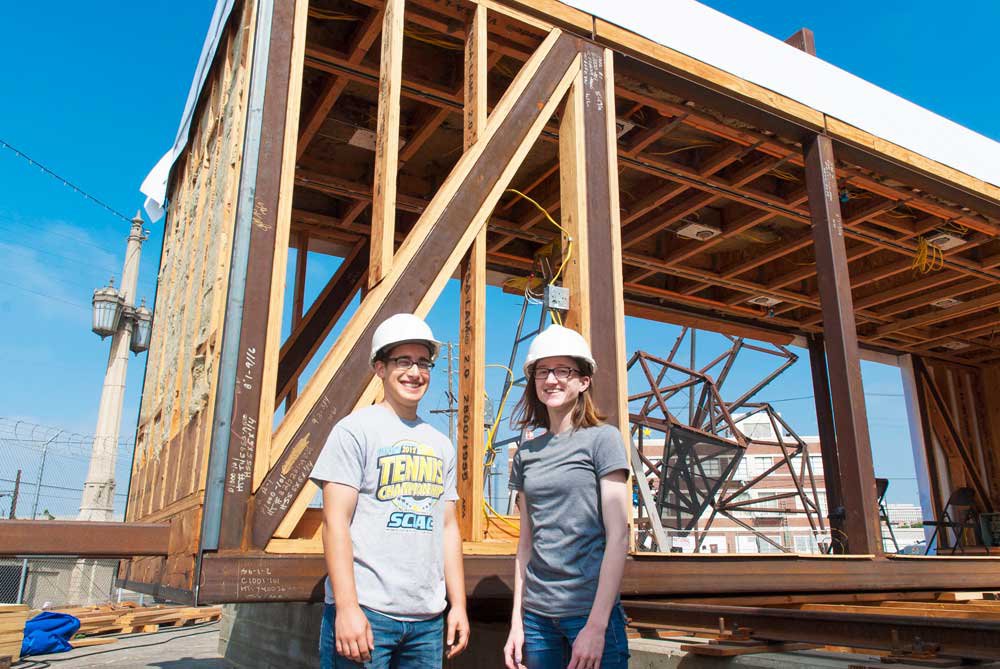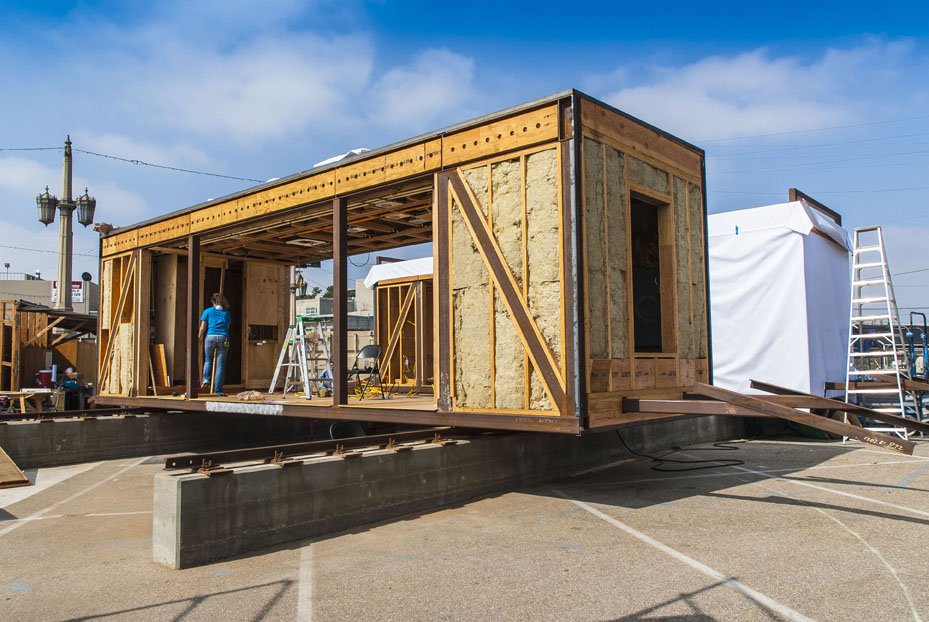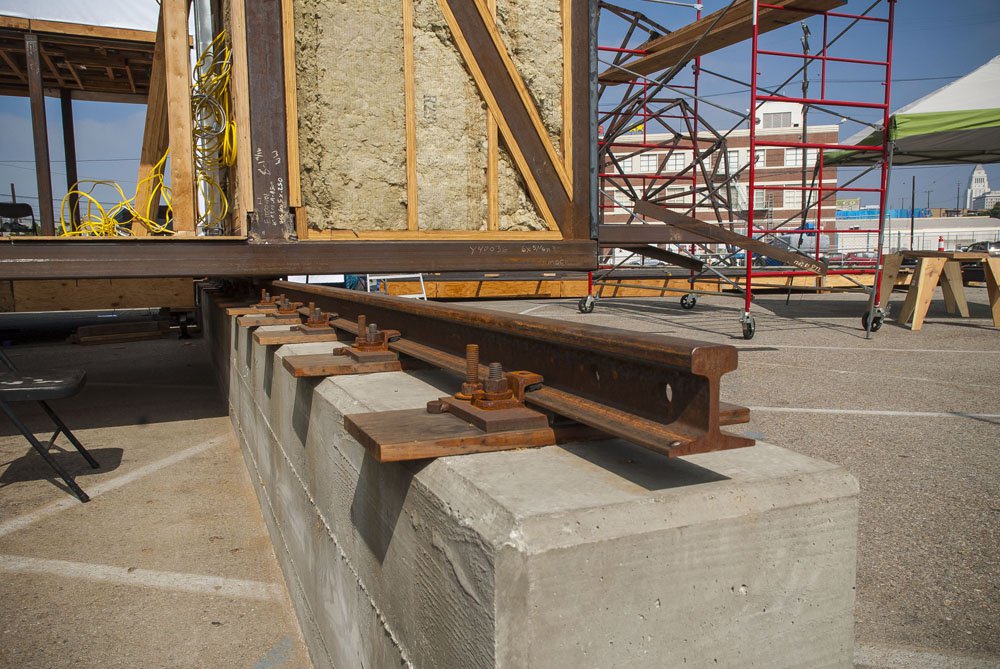Trading in their textbooks for power tools this summer, a group of nine Caltech students and recent graduates have had a unique opportunity to apply their classroom knowledge to real-world challenges. Along with students in architectural design from the Southern California Institute of Architecture (SCI-Arc), the Caltech students have spent their summer building the Dynamic Augmented Living Environment (DALE), a joint SCI-Arc/Caltech entry in the 2013 Solar Decathlon competition. DALE marks Caltech's second collaboration with SCI-Arc, following their Compact Hyper-Insulated Prototype (CHIP), the partnership's first Solar Decathlon entry, in 2011.
Sponsored by the Department of Energy, the biennial Solar Decathlon competition challenges collegiate teams to "design, build, and operate solar-powered houses that are cost-effective, energy-efficient, and attractive." Contest rules state that each entry must be a net-zero home, meaning that its solar panels must produce at least as much energy as the home uses.
Construction on the SCI-Arc/Caltech collaboration began in March, when DALE's cement foundation was poured. In April, the home's steel frames were dropped in, allowing the students (guided by a few construction professionals) to begin nailing the lumber into place.
As of August, the home is starting to take shape; the bathroom has been framed out, the kitchen cabinets are set for installation, and soon the house will be sporting a vinyl exterior and a set of moving canopies that will hold its solar panels.
Although construction work only began a few months ago, the Caltech students began planning for DALE last fall in an engineering project course called Introduction to Multidisciplinary Systems Engineering, taught by Melany Hunt, Dotty and Dick Hayman Professor of Mechanical Engineering and a vice provost.
"I really like this project because it's very hands-on," says DALE team member Zeke Millikan (BS '13, mechanical engineering). "A lot of classes at Caltech are very theoretical, and I'm more of a hands-on type of person. It's really satisfying to actually build something and see it come together."
"Prior to this summer," says DALE team member Sheila Lo ('16), "I didn't really have a lot of experience in construction, so I spent a lot of time learning the terminology and how to use which tools in certain situations. As one of the youngest members of the team, it's been a great privilege to work with upperclassmen and recent graduates because they've taught me a lot about dedication to a project and what it means to apply the skills you learn at Caltech."
And this dedication will be important in the coming weeks, as there is still plenty of work to be done for the early-October competition. Unlike the five previous Solar Decathlons, which were held in Washington, D.C., this year's event will take place in nearby Irvine, California. "Having the competition just right down the road from us inspired the design," says DALE team member Ella Seal (BS '13, mechanical engineering).
To capitalize on Southern California's mild climate, DALE is made up of two moving modules that can glide apart on warm sunny days, creating an open indoor courtyard that can triple the home's available living space. During inclement weather—and for enhanced safety and privacy—DALE's modules can also move together, creating an enclosed home of about 600 square feet.
The home's untraditional moving design—conceived by SCI-Arc team members—is more than just eye-catching. "It also will actually save energy and money over the course of the year," says Seal. By varying the configurations of DALE's modules and shade canopies—the same ones that will hold DALE's solar panels—the Caltech students were able to optimize energy efficiency during different times of the day without sacrificing comfort. "During the summer, the air-conditioning energy consumption drops by at least half when you are able to open up the house and adjust the shading depending on the weather outside," says Millikan.
But a moving house also presents several engineering challenges, says Seal. Wires for electricity and pipes for plumbing had to be specially designed for their moving platform. Seal and Millikan were also tasked with creating a foolproof safety mechanism for DALE's movement systems. Applying their backgrounds in mechanical engineering, they created a system of laser beams, light curtains, and pressure sensors that acts "basically like a garage door sensor on steroids," says Millikan. "We think we've addressed pretty much every scenario where someone could get seriously hurt."
In addition to the movement systems, students from Caltech are responsible for designing the home's heating, ventilation, and air-conditioning system; hot water system; photovoltaic arrays; and other engineering aspects of the solar-powered home. As well as their technical contributions, the Caltech students will collaborate with their SCI-Arc teammates on publicity and fund-raising efforts and the compilation of a final written report.
"I appreciate the fact that it's not just engineering," says Seal. "I really like the fact that we have to write an engineering narrative, describing all of the really cool innovations that we've built into the house. It's not necessarily something that I would get to do if I took a different project class at Caltech."
This type of multidisciplinary and collaborative experience is important for Caltech students, notes Hunt. "Engineering students need experiences in which they design, create, build, and test," she says. "They also should have opportunities in which they work as part of a team. Most engineering projects require multiple perspectives with input coming from a range of individuals with different expertise and vision."
In addition to Millikan, Seal, and Lo, the DALE team includes current Caltech students Brynan Qui ('15), Do Hee Kim ('15), Sharon Wang ('16), as well as recent graduates Tony Wu (BS '13, mechanical engineering and business economics and management) and Christine Viveiros (BS '13, mechanical engineering), and project manager Andrew Gong (BS '12, chemical engineering [materials]). The SCI-Arc/Caltech project, along with other entries for this year's Solar Decathlon competition, will be open to the public October 3–6 and 10–13 at the Orange County Great Park in Irvine, California.
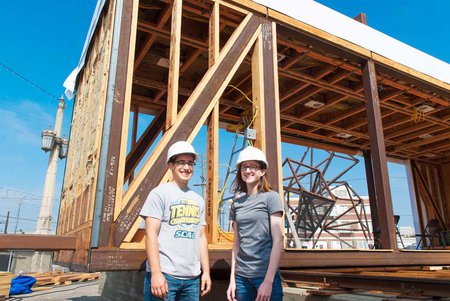 Recent Caltech graduates Zeke Millikan ('13, mechanical engineering) and Ella Seal ('13, mechanical engineering) in front of DALE at SCI-Arc in Los Angeles.
Credit: Jessica Stoller-Conrad/Caltech Office of Strategic Communications
Recent Caltech graduates Zeke Millikan ('13, mechanical engineering) and Ella Seal ('13, mechanical engineering) in front of DALE at SCI-Arc in Los Angeles.
Credit: Jessica Stoller-Conrad/Caltech Office of Strategic Communications
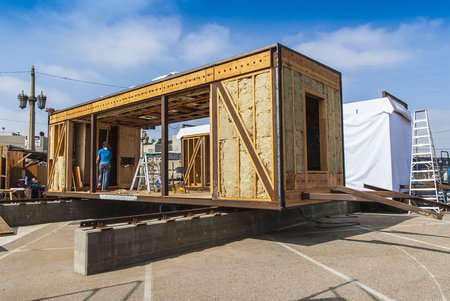 Dynamic Augmented Living Environment (DALE), the SCI-Arc/Caltech entry in the 2013 Solar Decathlon competition.
Credit: Jessica Stoller-Conrad/Caltech Office of Strategic Communications
Dynamic Augmented Living Environment (DALE), the SCI-Arc/Caltech entry in the 2013 Solar Decathlon competition.
Credit: Jessica Stoller-Conrad/Caltech Office of Strategic Communications
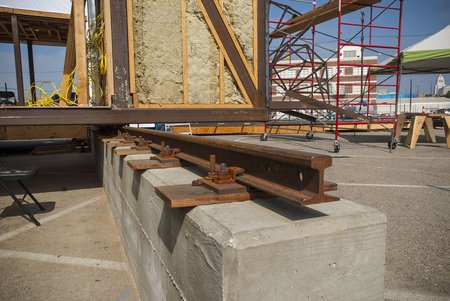 DALE's tracks: the home consists of two modules on tracks that can glide apart to take advantage of warm weather, or close together when it's cold and rainy.
Credit: Jessica Stoller-Conrad/Caltech Office of Strategic Communications
DALE's tracks: the home consists of two modules on tracks that can glide apart to take advantage of warm weather, or close together when it's cold and rainy.
Credit: Jessica Stoller-Conrad/Caltech Office of Strategic Communications
